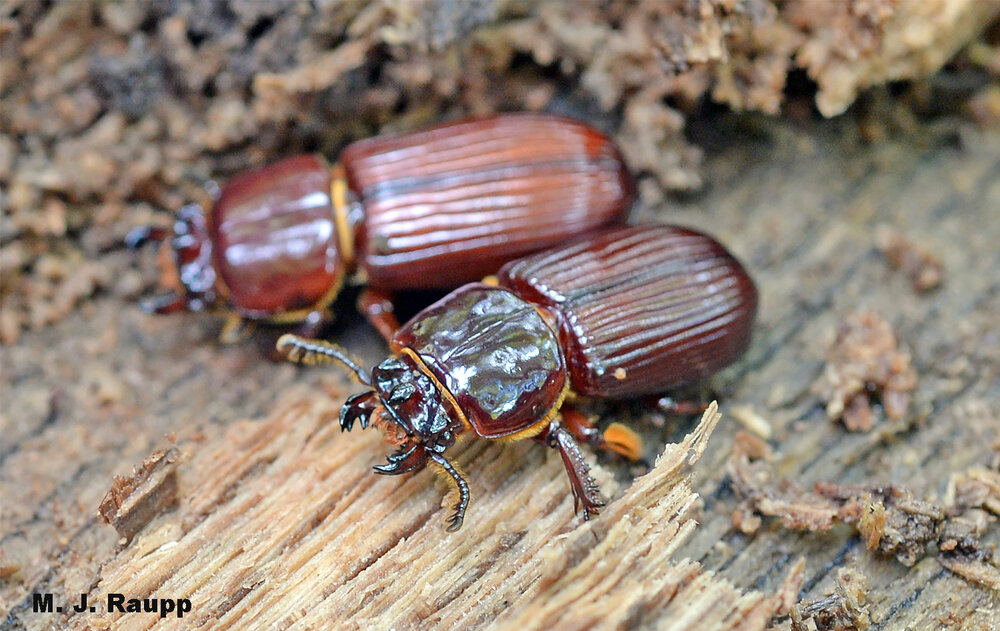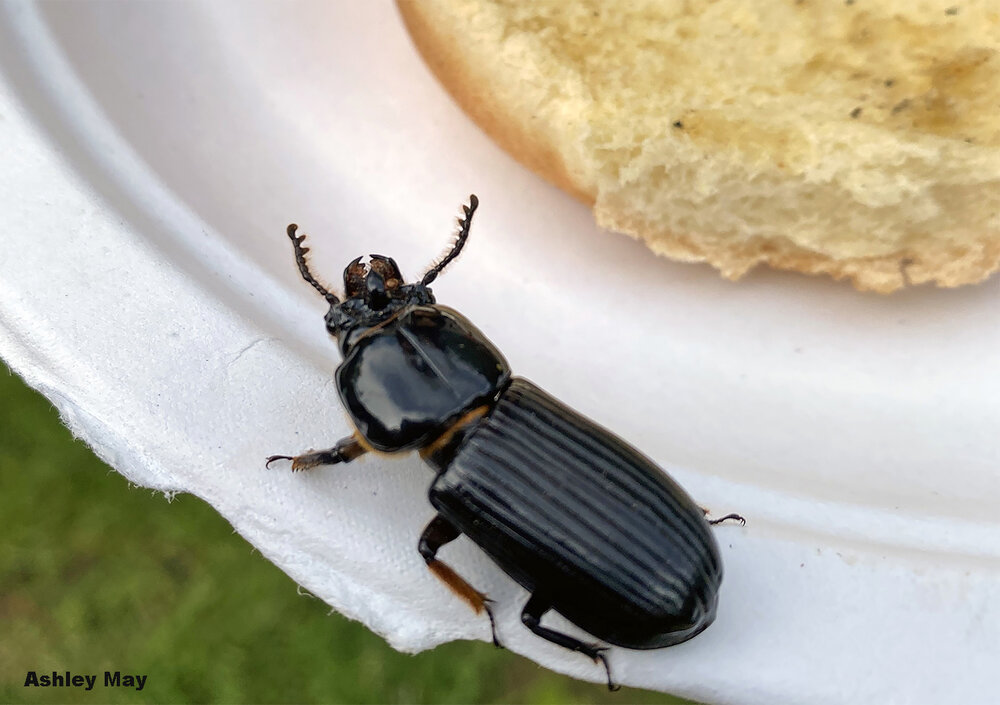Recyclers in the Circle of Life: Bess beetles, Odontotaenius disjunctus

These powerful jaws can gnaw through even super-tough wood like oak.

Dilemma for a bess beetle at a picnic “Do I go for the hamburger bun or find a dead tree to eat?” Image credit: Ashley May
Last week we visited blood-thirsty mosquitoes, ectoparasites high up the food web that feed on animals including us. This week we meet one of Mother Nature’s champion recyclers, bess beetles, whose mission is to repurpose tough wood fibers into cute beetle larvae. During the past week or two while wandering wooded trails, I have enjoyed several encounters with magnificent bess beetles as they scurried about the forest floor. Coincidentally, several images of bess beetles have arrived in my mailbox from other folks curious to learn about these lumbering beauties. Bess beetles are also known as patent leather beetles and the horned Passalus by virtue of their shiny deep brown color and notable horns. These powerful beetles are important participants in the great circle of life. No, they do not occupy an exalted place at the top of the food chain like Mufasa, the Lion King. They sit near the bottom of the heap along with fungi and bacteria where they help decompose fibrous wood. Adult bess beetles use strong jaws to gnaw and ingest wood. After being processed in the beetle’s digestive system and deposited back in the wood, the microbe-packed droppings, a.k.a. frass, are consumed by bess beetle larvae. The microbes contained in the leavings of the adult beetles are particularly important for young larvae that require parental microorganisms to help them digest wood. Tough plant tissues such as lignin and cellulose are indigestible to us, but the gut microbiome of the bess beetle and resident microbes found in decaying wood enable bess beetles to capture nutrients as they recycle tough plant polymers.
Bess beetles are among the champion recyclers of the insect world. A remarkable microbiome in their gut enables bess beetles to breakdown tough polymers found in wood and extract nutrients locked up inside. Now is a great time to observe bess beetles as they scramble across the forest floor or recycle wood beneath the bark of fallen trees.
Upon plucking a bess beetle from the forest trail, I was intrigued to hear it squeak. Bess beetles are able to produce sound by rubbing their wings across a rasp-like structure on the upper surface of their back just beneath the hard wing covers. This form of sound production is called stridulation. Many beetles, such as the milkweed longhorned beetle we met on June 27, 2016 in “Turning the tables on milkweeds: Milkweed longhorned beetle, Tetraopes sp.”, stridulate. The larvae of bess beetles are somewhat unique in that they also stridulate by rubbing together two sections of their legs. Several authors suggest squeaking sounds enable both larvae and adults to communicate with others in the decomposing wood. One account indicates that larvae follow the calls of adults in the colony. Perhaps this is a way for parents to assist their babies in discovering food or maybe it conveys a message akin to “eat your vegetables”. Other scientists believe the calls may frighten would-be predators. To learn the true nature of the call of the bess beetle, I made a recording of the sound. By playing the sound backward at very slow speed, the beetles could clearly be heard trilling the Gershwin classic “summer time and the livin’ is easy”. Guess summer must be right around the corner.
Acknowledgements
Bug of the Week thanks Ashley May for inspiring this episode and providing the nice image of a bess beetle that apparently joined her picnic. Information for this Bug of the Week came from two fascinating papers, “Gut anatomical properties and microbial functional assembly promote lignocellulose deconstruction and colony subsistence of a wood-feeding beetle” by Javier A. Ceja-Navarro, Ulas Karaoz, Markus Bill, Zhao Hao, Richard A. White, Abelardo Arellano, Leila Ramanculova, Timothy R. Filley, Timothy D. Berry, Mark E. Conrad, Meredith Blackwell, Carrie D. Nicora, Young-Mo Kim, Patrick N. Reardon, Mary S. Lipton, Joshua N. Adkins, Jennifer Pett-Ridge, and Eoin L. Brodie, and “Observations on the life history of the horned Passalus” by L.E. Gray.
This post appeared first on Bug of the Week